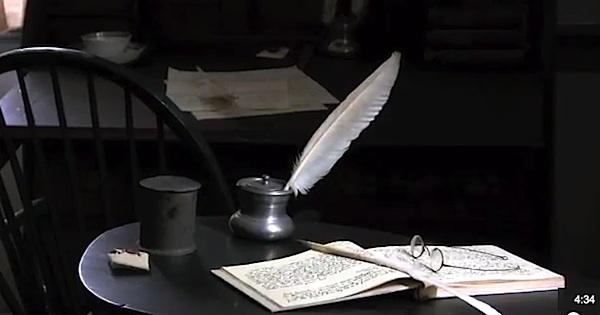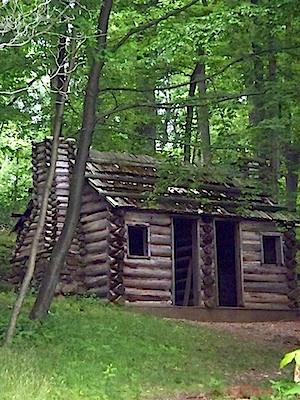
Inside the Ford Mansion you can see where General Washington spent hours over his war plans and writing letters to Congress asking for more support for the Continental Army/Kurt Repanshek
In north-central New Jersey, just a short distance from New York City, the Continental Army hunkered down in a place called Jockey Hollow for a long, cold, harsh winter of monitoring the British troops across the Hudson River in New York City.
Today you can get a feel for this setting -- though it's heavily urbanized these days -- with a visit to Morristown National Historical Park where General George Washington and 10,000-12,000 troops spent what's believed to be the coldest winter on record.
Though the winter encampment of 1777-78 for the Continental Army at Valley Forge draws much attention, the following winter in central New Jersey was actually much, much harder for the Colonials. It was so cold that winter that the Hudson River reportedly froze so hard and so thick that cannons hauled across it didn't crack the ice.
To stay warm, the 10,000-12,000 troops that descended on the the Henry Wick farm struggled through snow 2 feet deep, and drifts much higher, as they chopped down more than 600 acres of trees to build more than 1,000 small log huts and to keep warming fires burning through the days and nights.
As they arrived in camp, the soldiers pitched their tents on the frozen ground. Then work was begun at once on building log huts for more secure shelter from the elements. This was a tremendous undertaking. There was oak, walnut, and chestnut timber at hand, but the winter had set in early with severe snowstorms and bitter cold. Dr. James Thacher, a surgeon in Stark's Brigade, testified that "notwithstanding large fires, we can scarcely keep from freezing." Maj. Ebenezer Huntington, of Webb's Regiment, wrote that "the men have suffer'd much without shoes and stockings, and working half leg deep in snow." In spite of these handicaps, however, nearly all the private soldiers had moved into their huts around Christmastime, though some of the officers' quarters, which were left till last, remained unfinished until mid-February. A young Connecticut schoolmaster who visited the camp near the end of December described it as a "Log-house city," where his own troops and those of other States dwelt among the hills "in tabernacles like Israel of old." About 600 acres of woodland were cut down in connection with the project.
....
Logs notched together at the corners and chinked with clay formed the sides of the huts. Boards, slabs, or hand-split shingles were used to cover their simple gable roofs, the ridges of which ran parallel to the camp streets. All the soldiers' huts, designed to accommodate 12 men each, were ordered built strictly according to a uniform plan: about 14 feet wide and 15 or 16 feet long in floor dimensions, and around 6-1/2 feet high at the eaves with wooden bunks, a fireplace and chimney at one end, and a door in the front side. Apparently, windows were not cut in these huts until spring. The officers' cabins were generally larger in size, and individual variation was permitted in their design and construction. Usually accommodating only two to four officers, they had two fireplaces and chimneys each, and frequently two or more doors and windows. Besides these two main types of huts, there were some others built for hospital, orderly room, and guardhouse purposes. The completed camp seems to have contained between 1,000 and 1,200 log buildings of all types combined..
Several miles away, in Morristown, General Washington and his aides -- five aides de camp, along with 18 servants -- moved into the Ford Mansion. This sprawling, three-story home had been built just several years earlier for Jacob Ford, Jr. A colonel in the Continental Army, Ford didn't live to see Washington take over his home, dying in 1777 of pneumonia.
Here General Washington spent six months. The accommodations, and duration of his stay, allowed his wife, Martha, to join her husband through the winter and into the summer. During a guided tour of the mansion you'll see the dining room where the Washingtons entertained guests; their bedroom with its four-post, curtained bed; the study were the general worked on his war plans and wrote letters to Congress, beseeching the government to better outfit the thread-bare and starving troops, and; the spacious kitchen laid out as it might have been as servants worked on meals for the general.
Upstairs, you see the room where the widowed Mrs. Ford and her daughter and three sons lived during the general's occupation of her house. Small cots are set up in a hallway for some of the general's aides.

Replica log huts at Jockey Hollow impress on you the hardships the troops endured the winter of 1778-79/Kurt Repanshek
Though some of the furniture in the mansion is thought to be original, most of the pieces are replicas. After your tour of the house, cross the rolling lawn to visit Washington's Headquarters Museum, where you'll find military artfacts, including a huge link from a chain that was stretched across the Hudson to stop ships. Too, the museum displays a genuine Ferguson rifle and a British cannon said to have been captured at the Battle of Princeton.
Then make the short drive to Jockey Hollow and walk the grounds that sheltered the troops that harsh winter. Today only a few replica log huts remain, but they give you a great idea of how cramped the troops were and how brutal the winter there must have been. You'll also come upon an unmarked graveyard holding more than 100 graves of soldiers who died during the campaign.
Washington's Headquarters Museum
Address: 30 Washington Place, Morristown, NJ 07960
Phone Number: 973-539-2016 ext.210
Hours: 9 a.m. to 5 p.m., 7 days a week, Closed Thanksgiving, Christmas and New Year's Day
Ford Mansion
Address: 30 Washington Place, Morristown, NJ 07960
Phone Number: 973-539-2016 ext.210
Tour Times: 10am, 11am, 1pm, 2pm, 3pm and 4pm, 7 days a week. Tours are limited to 20 visitors per tour. You can purchase tickets at Washington's Headquarters Museum. All tickets are first come first served, no reservations. Closed on Thanksgiving, Christmas and New Year's Day.
Jockey Hollow Visitor Center
Address: 580 Tempe Wick Road, Morristown, NJ 07960 (approximately)
Phone Number: 973-543-4030
Hours: 9 a.m. to 5 p.m., 7 days a week, Closed Thanksgiving, Christmas and New Year's Day



Comments
Thanks, Kurt, for the interpretation of Morristown NHP, the first national historical park in the National Park System. Its original congressional sponsor was the father of the current Congressman Rodney Frelinghuysen (a family with generals and US Senators going back to the Revolution, and one of the Senators actually was the VP running mate for Henry Clay when they ran against Polk. Had they won, American would be a very different place. But, back to the founder of the park, he also expanded wildlife refuges, something his son has also done. The park in its way helps commemorate the great intensity of Revolutionary War activity in New Jersey (i heard at a park service workshop for their revolutionary war heritage area that surrounds the park that half of the engagements of that War happened in NJ)
In addition to the significance of the cold that no one reading your article will forget, a notable thing the park reveals is the most significant thing about George Washington's military success. Although many like to talk about his dreary record in the battles he fought, his great skill was proccupying the English while preserving his Army and remaining enticingly just out of the clutches of the King's Army. He used the SAME just-out-of-reach strategy at Valley Forge and at West Point, but New Jersey was the ultimate. Washingon used the geography and landscape of New Jersey brilliantly. Morristown sits on the ridge, the fall line, exactly where the ancient techtonic plates of Africa and North America once broke in two, and as a result, in the flatlands below and all around, those great swamp lands that many years later became those National Wildlife Refuges. On the other side to the East, New York Harbor and the King's Army and Navy. Americans regularly bushwacked any small party of English or their Hessian allies who tried to probe into New Jersey, and sending in any larger force would deplete English resources while the Americans could always dance away before the English arrived. Washington kept this up until the French signed on and trapped the English Army at Yorktown. Washington was not just hunkered down, it was a fairly aggressive strategy that one. If he could preserve his Army long enough he figured eventually the English would have to quit and he would win. Years later the Confederate Army in the Civil War tried something similar -- it did not work because the North had Lincoln. But the English had George III.
I just drove there and despite the website saying it is open every day (except Christmas, New Year's and Thanksgiving) it was closed. They are not open on Mondays or Tuesdays, FYI.
Unfortunately, Alison, this is 2018 and things have changed since this article was written. Something called Budget Cuts . . . . .
Going to have to find something else to blame Lee. Funding for the Longfellow house was higher in 2018 than in 2014.
Better do some checking, Esteeemed Comrade. You're a bit confoooosed.
Not a bit confused. Funding in 2014 was $1.173 million. In 2018, $1.226. I don't make baseless accusations formulated from a political bias. I check the facts before I post.
Then perhaps you'd better actually check the facts. Because you're still confooooooosed.
Lee -- Do me a favor? Rather than just tease the troll, will you please just state the facts you've found? I normally hope he will do his own research, but his political bias [thanks for first using the term here, Eric], his political bias won't allow him to set his blinders aside and he can't do more than cherry pick what he wants. I've been hoping to avoid mud wrestling this summer.